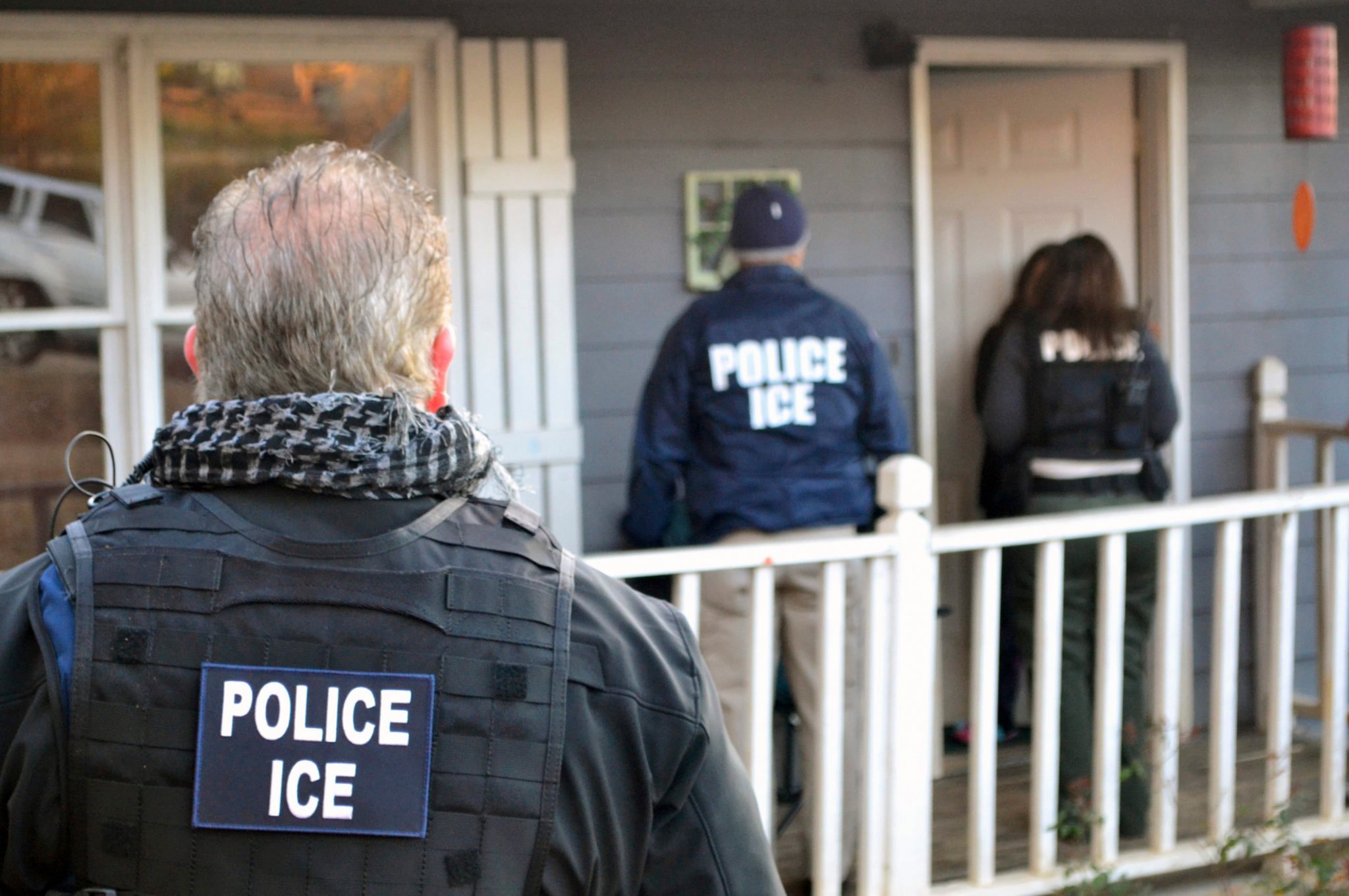No Way Out
Will The Border Patrol use hurricane evacuations to snag undocumented immigrants?
In July, as Hurricane Dolly made landfall in South Texas, Susanna, Raul, and their daughter Nayelly huddled in their two-room wooden shanty, watching water pour through cracks in the ceiling and walls. Dolly was only a Category 1 storm, but in the family’s unincorporated colonia—one of the country’s poorest communities—their home was one of many that didn’t stand a chance.
Susanna had wanted her family to flee the colonia, located just east of McAllen. “I looked at the house, with its flimsy walls,” she says, “and I thought, ‘What are we going to do here? We’re totally exposed.'”
As undocumented immigrants, Susanna and Raul felt they had no choice. In May, a U.S. Border Patrol spokesperson had told local media outlets that immigration checkpoints about 80 miles north of the border would continue operating during a storm. The agency later said it would “not impede evacuations,” but during Dolly, when evacuation was voluntary, agents stopped every vehicle headed out of South Texas. Susanna and Raul knew that if the family evacuated, they would be asked about their citizenship before continuing to Austin or San Antonio. (The family asked that their last name not be used because of deportation concerns.)
According to Texas State Demographer Karl Eschbach, about 150,000 of the Rio Grande Valley’s 1 million residents are undocumented. For that population, evacuation could come at a high cost. If the Border Patrol works checkpoints during a storm, Susanna and Raul could be detained, deported and separated from their 4-year-old daughter, a U.S. citizen by birth.
So while 23,000 South Texans evacuated during Dolly, Susanna’s family stayed put. Wind tore through plywood panels, spitting rain between gaps in their walls. It took three hours for the storm to destroy their home. The family huddled in their hallway, where they stayed safe. The next morning, they picked through the rubble and started looking for another place to live.
That was just over a year ago. After staying with friends a few weeks, Susanna and Raul moved to another home in the same colonia—a square place with a thin, metal roof and all-too-familiar gaps in the concrete façade. With another hurricane season here, there’s no comfort for Susanna.
“It’s all I think about,” she says. “What will we do if the big storm comes this year? Where will we go?”
150,000 undocumented immigrants will want to flee the Rio Grande Valley if a violent hurricane hits South Texas. But U.S. Border Patrol checkpoints might keep them from evacuating. Hear from Valley residents and U.S. Border Patrol agents in this audio slideshow. Produced by Kevin Sieff.Download Hi-Res Video (Quicktime) »
The Border Patrol has been even more emphatic lately about keeping its immigration checkpoints in Sarita and Falfurrias open during storms. The checkpoints are along the only highways linking the Valley to Central Texas, where evacuation routes run. Border Patrol officials tell the Observer that even those who evacuate South Texas in state school buses will be asked to prove their immigration status. Those in the country illegally will be detained.
“The checkpoint will remain open as long as it’s safe for the agents, the public, and the [checkpoint] structure,” says John Lopez, the Border Patrol’s Rio Grande Valley spokesperson. “If there’s an evacuation called, we’ll work closely with state and local officials to ensure a safe and speedy evacuation. … But that’s not going to preclude us from doing our job, which is to stop illegal entrants and narcotics and other threats from entering the country.”
Lopez says the checkpoints’ supervisors and the Border Patrol sector chief will decide whether to keep operating. Checkpoints won’t close, he says, until storms have made landfall—too late for families like Susanna’s to get out.
Community organizers and immigration attorneys have written to Homeland Security Secretary Janet Napolitano, asking that immigration enforcement be suspended during “any phase of emergency preparedness, relief, and recovery.” They’ve held small protests, marching with signs that read, “We don’t need a Katrina in the Valley.” It’s a bold analogy, but a potentially accurate one if the Valley’s legions of undocumented residents decide not to evacuate. In a place notorious for flooding, so close to the Gulf and protected by largely untested levees, there is plenty of reason for concern.
Because Susanna is here illegally, she hasn’t gone to protests. She can only wait and hope for a guarantee from the Border Patrol that her family can evacuate without fear of deportation. She’s pessimistic.
“If they checked papers during Dolly,” she asks, “what’s going to stop them from doing it again?”
Nothing, it appears. Last summer, even as hurricane-force winds blew in from the Gulf during Dolly, work continued at the Sarita and Falfurrias checkpoints. “We were in imminent danger,” says the Sarita checkpoint’s supervisor, Ruben Rendon. “High-gust winds, torrential-type rains. It was kind of eerie.” As conditions worsened, Rendon says, illegal activity increased. In the hour before the storm hit, agents say they confiscated 10,000 pounds of marijuana and apprehended dozens of undocumented immigrants.
Lopez says smugglers and undocumented immigrants were hoping the Border Patrol had relaxed enforcement during the storm. “It showed us that crime and extenuating circumstances go hand in hand sometimes,” he says.
If the checkpoints were closed during a storm this season, agents say, they worry that criminals would seize the chance to transport drugs and immigrants north from the Valley. But continuing operations at the checkpoints would dissuade thousands of undocumented Valley residents from following the suggested evacuation route to San Antonio.
It’s not just a source of anxiety for undocumented folks like Susanna and Raul. Some South Texans worry that serious traffic jams at the checkpoints could make evacuation difficult for U.S. citizens, too.
“We already pay a very large price for living on the border,” says Corinna Spencer-Scheurich, a Valley immigration attorney who signed the letter to Napolitano. “But this is asking us to pay the ultimate price of our lives.”
The checkpoints in Sarita and Falfurrias are gray, tollbooth-like structures spanning two highway lanes. Both are situated about 75 miles north of the border amid scrubby, South Texas ranchland. Traffic is substantial. In Falfurrias, 15,000 cars pass through every day, stopping an average of nine seconds.
The drill is familiar to South Texans. One agent walks a drug-sniffing dog around the vehicle. Another questions the driver and passengers: “Are you U.S. citizens?” the agent asks first. The next questions will be about the car’s contents, or the driver’s destination—anything that might make a drug smuggler or undocumented immigrant slip up. Because passports are not required, agents pay close attention to averted eyes and nervous gestures. If something seems off, the vehicle is searched. That’s how agents at Sarita and Falfurrias have found marijuana in truck tires and undocumented immigrants in piñatas and speaker boxes.
“Not only do we stop contraband smuggling and alien smuggling,” Rendon says. “We also use our line of questioning to find aggravated felons and other wanted criminals.”
Many immigrants circumvent the checkpoints, walking through ranches for 10 to 20 miles to avoid the questions. Every year, ranchers find bodies of immigrants unable to make the difficult journey. For thousands more, the checkpoints make leaving the Valley, even temporarily, impossible. Hospitals in Corpus Christi, attorneys in San Antonio and field trips to the state Capitol are all effectively off limits. (Border Patrol agents work the Valley’s airports, too.) Still, many try to slip through the checkpoints, and many are caught. In 2006, the Falfurrias station apprehended almost four times more undocumented immigrants—20,000—than the town’s population.
The Border Patrol uses the checkpoints as a second line of defense—a way of catching aliens and, more often, drugs that evaded authorities at the border. The Department of Justice considers the checkpoints the “functional equivalent of the border,” meaning that agents don’t need probable cause to search vehicles and question passengers. There are 33 checkpoints along the Southwest border—17 in Texas—and one in northern New York state. In 2005, 8 percent of undocumented-immigrant apprehensions were made at interior checkpoints. The same checkpoints were responsible for 31 percent of the marijuana and about 74 percent of the cocaine seized nationally—418,102 pounds of marijuana and 10,853 pounds of cocaine in fiscal year 2004, according to a 2005 report (the most recent) by the federal Government Accountability Office.
According to the GAO’s 2005 report, “Border Patrol does not systematically evaluate the effectiveness of interior checkpoint operations,” so GAO auditors couldn’t complete their assessment of the checkpoints’ productivity. “[A] lack of data makes it difficult to estimate the direct costs of interior traffic checkpoints,” the GAO found. Neither could the researchers quantify the indirect costs of the checkpoints, such as delays caused to commuters and commercial shippers. (A new GAO report is due in late August.)
Lack of proof that they work hasn’t stopped the Border Patrol from increasing the number of interior checkpoints since 1976, when the U.S. Supreme Court ruled them constitutional. Eight of the agency’s nine sectors along the Southwest border now have checkpoints, all of them between 25 and 100 miles north of the border.
In keeping with their near-universal support for Border Patrol expansion and funding, politicians have backed the checkpoints enthusiastically. For more than a decade, Tucson Congressman Jim Kolbe, an Arizona Republican, was a notable exception, blocking a checkpoint in his district by withholding funding from his seat on the House Appropriations Committee. Kolbe wasn’t “soft” on immigration; he was known as a tough guy on border security. But Kolbe objected to what he saw as the checkpoints’ encroachments on the freedom of American citizens along the border. He worried about the impact on trade and traffic, and he questioned the strategy’s effectiveness.
“It’s an admission that we’re unable to have control at the border,” Kolbe says. “There is already a checkpoint—a checkpoint at the border. To say to people who live near the border that even though you’re American citizens, you’re going to be disturbed every day—that’s unacceptable.”
So why haven’t other border-area members of Congress raised objections? “They’re afraid to do it,” Kolbe says. “Everyone wants to look like they’re hard on illegal immigration.”

In the aftermath of 1967’s Hurricane Beulah, the federal government opened the U.S.-Mexico border, providing refuge to thousands of Mexican nationals, who were taken by helicopter to Rio Grande Valley shelters. “If the refugees come, we’ll take care of them,” Harry Lewis, Brownsville’s civil defense director at the time, told The New York Times.
That humanitarian spirit did not last. The operation of immigration checkpoints during a hurricane evacuation never entered the conversation when the Supreme Court determined they were constitutional in 1976. “Under the circumstances of these checkpoint stops,” Justice Lewis Powell wrote in the majority decision on United States v. Martinez-Fuerte, “the Government or public interest in making such stops outweighs the constitutionally protected interest of the private citizen.”
The court’s decision changed the way immigration laws are enforced during natural disasters.
In the decades since Beulah, the Border Patrol has become increasingly inflexible during hurricane season—particularly in South Texas, where checkpoints north of Brownsville, McAllen and Laredo operate 24 hours a day, 365 days a year, no matter what. In Louisiana—where there are no permanent checkpoints, only “floating” ones—the Department of Homeland Security has made it clear that immigration enforcement will not interfere with evacuations. As Louisiana braced for Hurricane Gustav in 2005, DHS released a memo in English and Spanish: “There are no immigration enforcement operations, and there are no immigration enforcement checkpoints associated with the evacuations.”
The federal government has never issued a similar reassurance in South Texas, though they haven’t been put to the test by a Category 1, 2 or 3 hurricane since the checkpoints were established. “Why here do we have a non-negotiable checkpoint, while in Louisiana that issue is negotiable?” asks Spencer-Scheurich, the immigration attorney. “They’re saying they would rather catch a shipment of marijuana than assure the people of South Texas don’t die because they can’t get out of the Rio Grande Valley. It makes me angry they would prioritize a drug-enforcement mission over people’s lives.”
“In the event of a natural disaster,” says Federal Emergency Management Agency spokesperson Matt Chandler, “our first priority is facilitating the safe evacuation of people leaving the danger zone.” With storms before Hurricane Dolly, officials had used similar language to reassure South Texans. But checkpoints did not shut down. Asked if operations would cease during a mandatory evacuation, Chandler declines to be specific. “That’s a total hypothetical situation,” he says.
Not really. Some of the most intense storms ever to strike the United States have landed on the shores of South Texas. While it’s been nearly three decades since a Category 3, 4, or 5 storm blew through the Rio Grande Valley, meteorologists say the area’s residents should be on their toes. “The chance of another Beulah in South Texas exists every year,” says Nezette Rydell, meteorologist in charge for the National Weather Service in Brownsville. “Every year there is a 33 percent chance of a strike on the Gulf Coast.”
When a violent storm appears imminent, it’s up to state and local governments whether to call an evacuation. Immigration checkpoints, however, lie exclusively in the federal domain. Officials at the Border Patrol’s national office say the agency might consult with FEMA about enforcement efforts during a storm.
“If FEMA says traffic isn’t moving fast enough,” says Border Patrol spokesperson Mark Qualia, “we will consider their recommendation. But an evacuation wouldn’t preclude us from questioning individuals involved in criminal activity in the United States … including those without legal status.”
The Border Patrol’s policy forces South Texas’ emergency officials to work around a federal policy that affects about 15 percent of the Valley’s nearly 1 million residents. In a mandatory evacuation, Cameron and Hidalgo counties plan to take residents to Central Texas in school buses before a storm makes landfall. Border Patrol officials tell the Observer that agents will check the immigration status of all evacuees, even those on the counties’ buses. “We’ll check every single person,” says spokesperson Lopez.
The Border Patrol’s hard line might be no more than that, says Cameron County Judge Carlos Cascos. In private conversations, he says, agents have implied that they will not check the immigration status of every last evacuee. “I have confidence that if there’s a Category 3, 4, or 5 storm and they see a line two miles long of vehicles and buses, they’ll get the order to wave them on,” Cascos says. “But they’re not going to come out and say that.”
Cascos knows that without a public announcement, undocumented immigrants are unlikely to flee to safety. Cascos plans to provide pub
ic buses to evacu
te residents directly west instead of northwest to San Antonio—not just away from the checkpoints, but also away from the state’s suggested evacuation route.
Busing residents westward to Hidalgo or Starr counties is far from a perfect solution. During Dolly, those counties had worse flooding than the area adjacent to the Gulf. “There’s no easy solution to this,” Cascos says. “You’re talking about state and local authorities trying to save things, but you’re dealing with another bureaucracy which is the federal government. And their priority is security and immigration enforcement.”
South Texans are still waiting for Secretary Napolitano to indicate that immigration enforcement will give way to safety during evacuations. Without a promise that they won’t be detained, South Texans like Susanna and Raul aren’t going anywhere. If conditions get really bad, Susanna says, she might send her daughter to San Antonio with friends who are legal residents. She and Raul will hunker down in their narrow hallway, remembering Dolly, saying prayers and waiting out the storm.
“We’ve been [in Texas] for eight years,” Susanna says. “This is our home. If we leave, we won’t be able to come back. It’s just too big of a risk.”
Kevin Sieff is an Observer contributing writer based in Washington, D.C.


